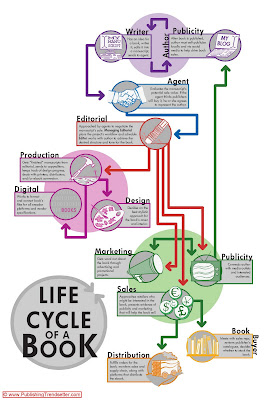
The weekend’s unwelcome snowstorm (seriously, nature, how am I supposed to traipse about dressed as a steampunk masquerader if you insist upon sleeting everywhere?!) reminded me of a rule that’s universal, not just to publishing, but to any industry: the “sometimes sh*t happens” rule.
Like the folks in any business, the editors, agents, and marketers of the publishing world are extremely cautious. From a book’s acquisition to its editorial process to its
cover design to its marketing campaign, few decisions are made without the input and approval of multiple departments.
Before a book is acquired, its potential sales are mapped out by its editors and then scrutinized by an acquisitions team. The house considers whether the manuscript is on a salable topic, whether the writing style suits the audience that the publishing house typically serves, how much editing and marketing will be required to make the book a success, and what the author’s and agent’s monetary expectations will be—not just for an advance, but also for an investment in terms of advertising and co-op dollars, travel costs for author book tours or conference attendance, and miscellaneous costs like unique photo shoots for the book cover or a redesign of the author’s website. Countless profit-and-loss statements are generated to prove that the project’s returns will be worth the investment. The manuscript is compared to projects being acquired by other houses to determine whether it’s likely to be what readers are looking for in two years (when it’s released as a book)—will it fit with a trend that seems to be gaining momentum? Will it be unique enough to stand out from the other books being released at the same time? Does it fulfill a need or an interest that readers in two years are likely to have?
That’s not to say that publishing houses never take risks, bring on a project out of love even though it might not make a good deal of money, or take on a project that requires a large up-front investment. I’ve seen all of those things happen when an acquisitions team gets really excited about a project.
But, though it’s important in all cases, in those cases it’s especially vital that the book’s production and marketing are carefully planned for success. The editor might see more of a chance of success for the book if it could be read by middle schoolers than by high schoolers, and might work with the author to simplify his or her writing to suit that market. The marketing team will help guide the editorial and production departments to release the book at the right time for relevant holiday promotions, back-to-school reading or summer reading lists, or to be released before a potential competitor hits shelves. Publicists carefully strategize about when and where to schedule tour stops and media campaigns, and marketers carefully plan to release buzz-builders like book trailers, chapter excerpts, games and more at the right time to build excitement just before the book’s release. Few elements of a book’s creation are simply left to fate.
But (without getting too philosophical on you), aren’t we all subject to forces outside of our control? Sometimes, despite all that good planning, sh*t just happens.
Sometimes a topic that looks like it will become trendy never quite gets off the ground. Sometimes a competitive title’s release date switches and there’s nothing your publisher can do to rush your book to come out first. Sometimes a major retailer decides not to stock a book, or to shelve it in a section that doesn’t really fit its content or intended audience. Sometimes a launch party is totally overshadowed by a citywide event that the publisher didn’t get wind of in time to reschedule, and no one comes. Sometimes a newspaper article gets pushed back or canceled to make room for breaking news. Sometimes an expensive online ad runs at a time when a major internet provider is suffering outages, and a far-smaller-than-intended audience actually sees it. And sometimes everything goes right with the book’s acquisition, editing, and marketing and publicity, but for whatever reason the book just doesn’t work.
Risk is a fact of life in this industry, and as frustrating as snow in October can be, there’s little to be done about it but hit the drawing board again and come up with a plan to counter potential losses. A first-rate publishing professional possesses not only an uncanny knack for predicting trends and outcomes and spotting the factors that usually lead to success, but also the flexibility to completely overhaul plans that don’t seem to be working as expected.
What does that mean for writers? To some extent it means that there’s no guarantee of success, which may be disheartening to hear. But because it’s understood that sh*t happens, it also means that you might get a second chance at success if your first, second, or even thirtieth book is a flop. Publishers and agents understand that some forces are outside your control, and with solid planning and the ability to learn from their mistakes, they might be able to engineer a past failure to become tomorrow’s bestseller.
How about you—has the unexpected ever gotten in the way of your career plans? How do you plan for success despite the risks? What do you do when your plans go awry?
 So, once your book's lifecycle is pretty much finished and it's hit bookstore shelves, your work is done, right? Wrong!
So, once your book's lifecycle is pretty much finished and it's hit bookstore shelves, your work is done, right? Wrong!


















